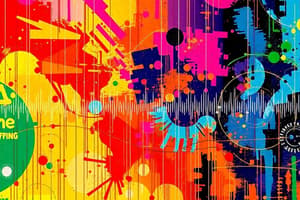Podcast
Questions and Answers
What are the three core steps in Analog to Digital (A/D) conversion?
What are the three core steps in Analog to Digital (A/D) conversion?
Sampling, Quantization, and Coding
What is the Nyquist rate?
What is the Nyquist rate?
The sampling frequency that is greater than twice the maximum frequency of the signal.
If a voice signal contains frequencies up to 4kHz, what is the appropriate sampling frequency that can be used?
If a voice signal contains frequencies up to 4kHz, what is the appropriate sampling frequency that can be used?
- 4 kHz
- 8 kHz (correct)
- 10 kHz
- 8.0 kHz
What is the maximum frequency contained in the given example signal, and what is the sampling frequency used?
What is the maximum frequency contained in the given example signal, and what is the sampling frequency used?
The sample rate guarantees that information is lost in the sampling process.
The sample rate guarantees that information is lost in the sampling process.
What happens if the sample rate is lower than the Nyquist rate?
What happens if the sample rate is lower than the Nyquist rate?
Who formulated the sampling theorem?
Who formulated the sampling theorem?
Flashcards are hidden until you start studying
Study Notes
What is Analog to Digital Conversion?
- Analog to digital (A/D) conversion is a process that converts an analog signal into a digital signal. It's done in three core steps: sampling, quantization, and coding.
Sampling
- The process of taking samples of a continuous-time signal at regular intervals.
- Sampling rate (fs) is the number of samples taken per second.
- The Nyquist-Shannon Sampling Theorem states that a signal can be perfectly reconstructed from its samples if the sampling frequency is at least twice the highest frequency in the signal.
- This minimum sampling rate is called the Nyquist rate.
Example of Sampling
- To sample a signal with a maximum frequency of 20kHz, we need a sampling frequency of at least 40kHz.
Quantization
- The process of converting a continuous range of values into a discrete set of values.
- This process maps a range of values to a limited number of levels.
- It's about representing the continuous amplitude of the signal with discrete values.
Reconstruction
- The process of converting a sampled signal back into a continuous-time signal.
- It involves reconstructing the original signal based on the samples.
Reconstruction Example
- A sampled signal with a maximum frequency of 4kHz can be perfectly reconstructed using a sampling frequency of at least 8kHz.
- The Nyquist rate for a signal with a maximum frequency of 6.3662 Hz is 12.7324 Hz.
- If a signal is sampled below the Nyquist rate, the resulting digital signal will not be a perfect representation of the original signal.
Digital Images
- They are composed of pixels.
- Each pixel represents a specific colour.
- Images are processed by performing operations on the pixels, such as filtering, edge detection, and compression.
Python
- Used for digital signal and image processing.
- Libraries like NumPy, SciPy, and OpenCV can be used for tasks such as image manipulation, video processing, and signal analysis.
Studying That Suits You
Use AI to generate personalized quizzes and flashcards to suit your learning preferences.




